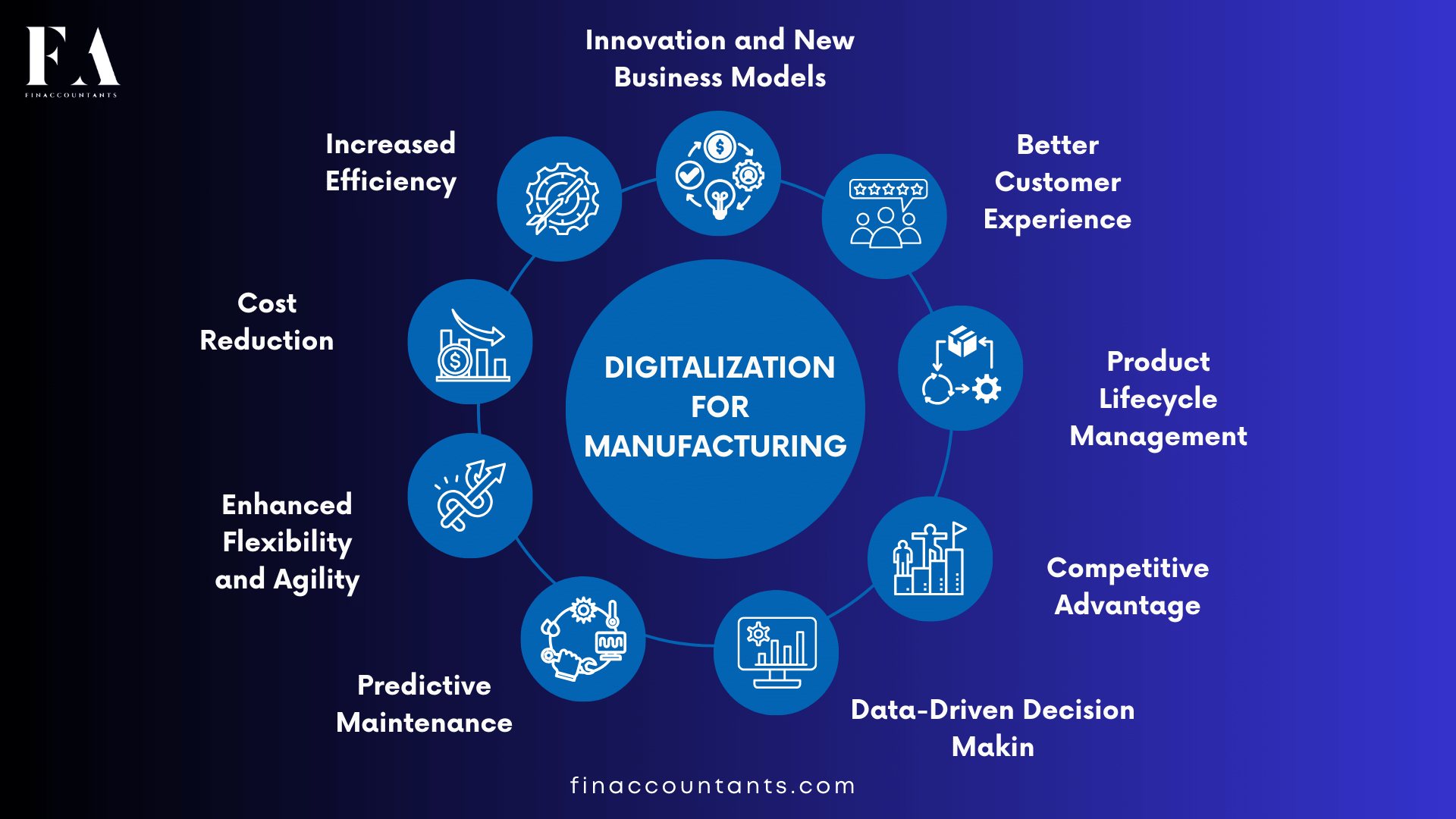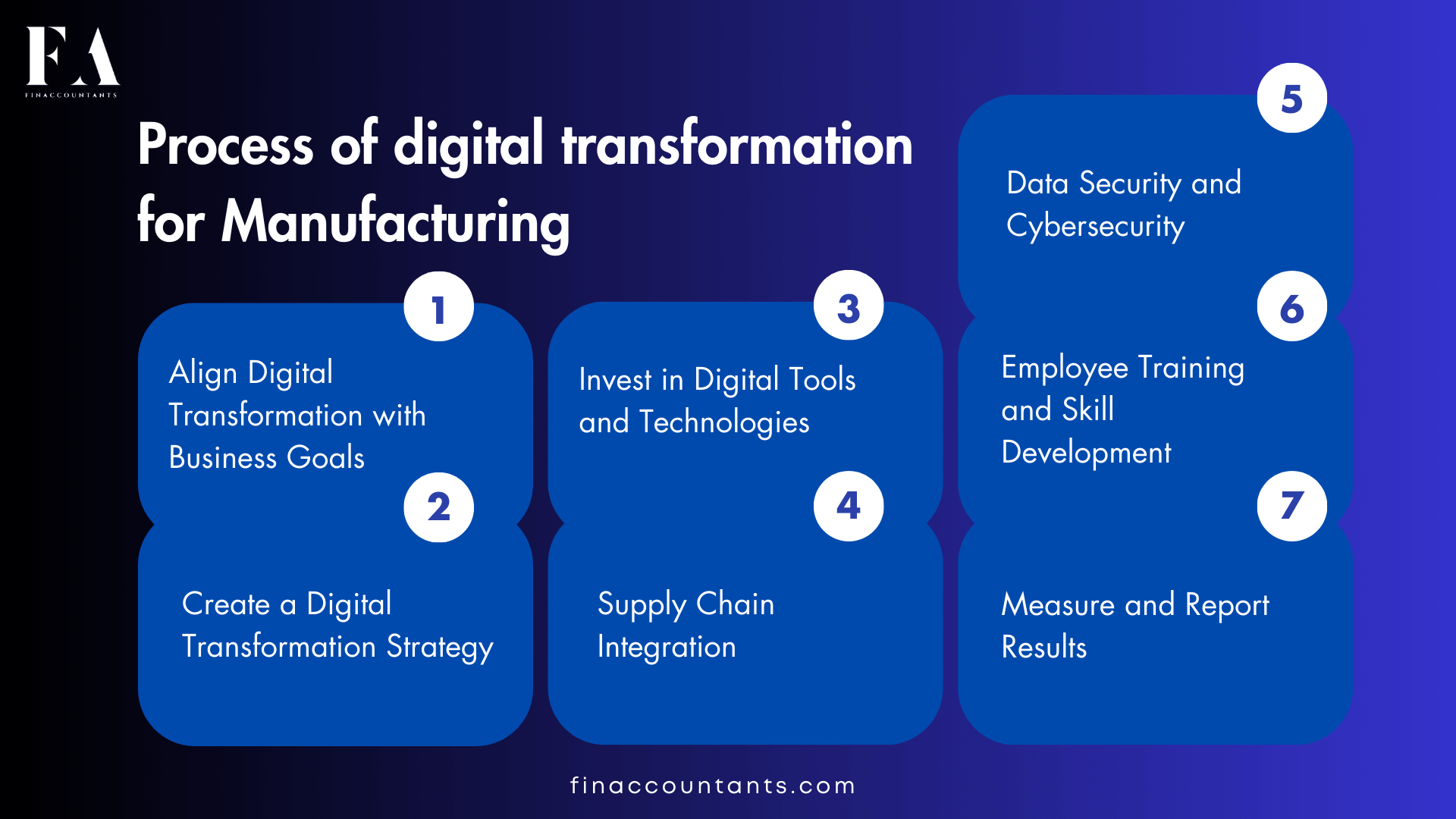What is Industry 4.0?
Industry 4.0 results from the rapid fusion of new technologies, including artificial intelligence (AI), the Internet of Things (IoT), robotics, and additive Manufacturing. These breakthroughs reshape entire industries and alter how businesses run, compete, and generate value.
Why digitalization and Industry 4.0 is essential for Manufacturing?
In an environment where competition is escalating, and technology is driving change, firms must adapt to Industry 4.0. In the 4th Industrial Revolution era, businesses can unlock new growth prospects, improve their competitive advantage, and provide sustainable value by embracing digital transformation, utilizing emerging technology, and building an innovation culture.
Every aspect of the business can be impacted by digital transformation. The leverage from digitalization for Manufacturing can be defined as:

- Increased Efficiency: Digitalization enables real-time monitoring of manufacturing processes and equipment, leading to better resource allocation and reduced downtime. This, in turn, enhances overall production efficiency.
- Cost Reduction: By optimizing processes, reducing waste, and improving resource utilization, digitalization can lead to significant cost savings in energy consumption, material usage, and maintenance.
- Enhanced Flexibility and Agility: Digitalized manufacturing processes can be more easily reconfigured or adapted to accommodate product demand or design changes. This flexibility is crucial in today’s rapidly changing markets.
- Predictive Maintenance: IoT sensors and data analytics allow for predictive maintenance, reducing unplanned downtime by identifying equipment issues before they lead to failures.
- Data-Driven Decision-Making: Digitalization provides access to vast amounts of data, enabling manufacturers to make informed decisions based on real-time information and historical trends.
- Competitive Advantage: Manufacturers embracing digitalization gain a competitive edge by being more agile, responsive to customer needs, and innovative in their approaches.
- Product Lifecycle Management: Digital twins and other tools support better managing the entire product lifecycle, from design and production to maintenance and retirement.
- Better Customer Experience: Meeting customer demands for faster delivery, customized products, and transparency in Manufacturing. Improving the process can increase customer satisfaction and loyalty.
- Innovation and New Business Models: Digitalization opens opportunities for new business models, such as servitization, where manufacturers offer products as services, creating new revenue streams.
The process of digital transformation for Manufacturing
Leveraging digital transformation for Manufacturing involves strategically integrating digital technologies and procedures to achieve specific business objectives. Here’s a step-by-step guide on how to do it effectively:

Align Digital Transformation with Business Goals:
Start by identifying your manufacturing organization’s strategic goals. Determine how digital transformation can help achieve these goals, whether improving efficiency, reducing costs, enhancing product quality, or expanding into new markets.
Create a Digital Transformation Strategy:
Develop a comprehensive digital transformation strategy that outlines your vision, objectives, and roadmap. This strategy should consider technology, people, processes, and data.
A digital transformation strategy helps leaders answer the following questions for their business:
- Where are you now?
- Where do you want to be?
- How are you going to get there?
Invest in Digital Tools and Technologies:
Identify the digital technologies and tools that align with your strategy and can address your specific challenges. Common technologies include:
- Internet of Things (IoT): A network of linked sensors and devices known as the Internet of Things gathers and sends data. IoT in Manufacturing offers real-time communication between devices, systems, and products, boosting productivity and efficiency.
- Big Data and Analytics: Analyze the data collected to gain insights and make data-driven decisions.
- Cloud Computing: Store and access data and applications in the cloud for scalability and accessibility.
- Artificial Intelligence (AI) and Machine Learning: With artificial intelligence (AI), machines can now learn and carry out tasks that ordinarily demand human intelligence. AI may be used to enhance quality control, decrease downtime, and optimize production processes. Use AI algorithms to optimize operations, predict maintenance needs, and automate tasks.
- Augmented Reality (AR) and Virtual Reality (VR): Enhance training, maintenance, and product design processes.
- Blockchain: Securely manage and track the supply chain and product lifecycle.
Supply Chain Integration:
Digitally connect your supply chain to gain inventory, demand, and logistics visibility. This helps in optimizing inventory levels, reducing lead times, and enhancing supply chain efficiency, and manufacturers can:
- Benchmark and improve performance across the supplier network
- Carry out system-wide capacity planning and load balancing.
- Activate full traceability to ensure standards are achieved, and necessary data is collected.
Data Security and Cybersecurity:
The ability to securely share manufacturing data from sensors to supply chains, machines to machines, and machines to humans at the right time and place, with the proper form and technology, and the best involvement of people, is the foundation of the economics of Smart Manufacturing1, IoT, Manufacturing 4.0, and Industry 4.0.
Employee Training and Skill Development:
Invest in training and upskilling your workforce to ensure they can use and maintain digital technologies effectively. Encourage a culture of continuous learning.
Measure and Report Results:
Define key performance indicators (KPIs) to measure the success of your digital transformation efforts. Regularly track and report on progress toward your objectives.
Conclusion
Overall, digitalization empowers manufacturing companies to become more competitive, agile, and customer-focused while contributing to sustainability efforts and regulatory compliance. It’s a strategic investment that can yield long-term benefits and help manufacturers thrive in the industry’s evolving landscape.
The possibility to increase operational effectiveness, save costs, and improve the customer experience is tremendous, thanks to the digital transformation in the manufacturing industry.
Finaccountants help manufacturing sectors with Rapid technological advancements and the rising desire for more effective, sustainable, and data-driven operations.
If you need any assistance for the growth of your business, feel free to contact Finaccountants.
FAQs
Q. What are the potential risks associated with relying heavily on digital technologies in Manufacturing?
A. Risks include cybersecurity threats, data breaches, technology obsolescence, and over-reliance on automation, leading to skill gaps. Manufacturers must have robust risk management strategies in place.
Q. What are the common challenges manufacturers face when implementing digital transformation initiatives?
A. Implementing digital transformation can be complex. Challenges include the high initial investment costs, data privacy concerns, finding skilled talent, and integrating new technologies with existing systems.
Q. How can small and medium-sized manufacturing businesses with limited resources embrace Industry 4.0 effectively?
A. Smaller manufacturers can start by prioritizing critical areas for digitalization, seeking cost-effective solutions, and considering partnerships or collaborations with technology providers to access expertise and resources.
Q. How does regulatory compliance fit into the digital transformation journey for manufacturers?
A. Compliance with industry-specific regulations, especially in highly regulated sectors like pharmaceuticals or aerospace, is crucial. Digital transformation should include measures for ensuring compliance, traceability, and data integrity.
Q. How can manufacturers ensure that their digital transformation efforts remain agile and adaptable in the face of rapidly evolving technology trends?
A. Staying agile involves continuous monitoring of technology trends, regularly updating the digital strategy, and fostering a culture of innovation and adaptability within the organization. Manufacturers should also be open to experimenting with emerging technologies.


Leave a Reply